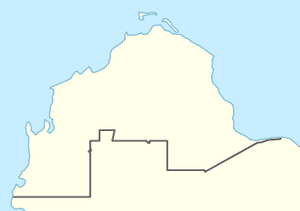Al Shamal
Al Shamal (Arabic: الشمال, romanized: Ash Shamāl) is a municipality in the state of Qatar. Its seat is called Madinat ash Shamal and it is considered to be one of the major cities in Qatar.[2] The seat's name translates to "city of the north"[3] - although the population is barely over 5,000.
Al Shamal الشمال | |
|---|---|
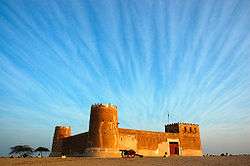 Zubara Fort | |

Map of Qatar with Ash Shamal highlighted | |
| Coordinates (Madinat ash Shamal): 26.07°N 51.13°E | |
| Country | |
| Capital | Madinat ash Shamal |
| Zones | 3 |
| Government | |
| • Mayor | Hamad Jumaa Al Mannai |
| Area | |
| • Total | 859.8 km2 (332.0 sq mi) |
| Population (2015)[1] | |
| • Total | 8,794 |
| • Density | 10/km2 (26/sq mi) |
| Time zone | UTC+03 (East Africa Time) |
| ISO 3166 code | QA-MS |
Ras Rakan, the Qatari Peninsula's northernmost point, is included in the municipality, and as such is surrounded by the Persian Gulf in all directions except for the south. It borders the municipality of Al Khor. The municipality is divided into three primary zones.
History
.jpg)

Al Shamal Municipality was established in July, 1972 alongside Qatar's four other initial municipalities.[4]
Accommodating less than 9,000 inhabitants, Al Shamal is the least populous municipality in the country. As it comprises the northernmost portion of the country, its historic importance is attributed to its more moderate weather and close proximity to Bahrain.[5]
The traditional mainstay of its inhabitants was fishing and pearling.[5] As early as the 16th century, Al Huwailah, located on the east coast of Al Shamal, served as Qatar's chief town. It was eventually overtaken by Al Zubarah, a town located in the western section of the municipality, which grew to be the largest and most important settlement in Qatar during the 18th century.[6] A survey conducted by the British Hydrographic Office in 1890 reflects on the subsequent abandonment of Al Zubarah as well providing details of the surrounding area's geography:
"Ras Ashiraj [Ras Ushayriq] is a low rocky point, 16 miles S.W. of Ras Rakkin, to the eastward of which is a bay 1½ miles deep, but shallow. On the east side of this bay stands the once important town of Zubara, of which extensive ruins are still to be seen; it is now abandoned, and the inhabitants have removed to Moreyr [Murair]. Vessels from Bahrain to Zubara generally sight Ras Rakkin, and then skirt the shore reef in 4 or 5 fathoms, till Khor Hassan tower is sighted. The large fort at Moreyr should then be seen; it is situated on slightly rising ground, about 1½ miles inland, between Zubara and Fariha."[7]
A unique system of partnership between coastal and inland villages was historically prevalent. Groundwater would be very difficult to obtain from settlements located directly on the coast due to the intrusion of seawater. Thus, coastal villages would trade prized marine resources such as fish in exchange for resources obtainable only from inland areas such as freshwater and crops. Examples of these historical partnerships include the Fuwayrit–Zarqa partnership and the Al Ghariyah–Al `Adhbah partnership. Another way settlements obtained freshwater was by excavating rawdas to create small reservoirs that would fill during rainy season.[8]
Proceeding the discovery of oil, most of Al Shamal's population migrated to the capital Doha.[5] In the mid-20th century, the region once again experienced significant population outflow due to upper aquifer salinization resulting from the overuse of diesel-powered water pumps. Nonetheless, once Qatar had begun reaping profits from its oil extraction activities, many northern settlements became repopulated as it had become feasible to transport water over longer distances.[9]
Geography
Accounting for roughly 7% of Qatar's overall landmass, Al Shamal is the northernmost municipality, its outermost point being Ras Rakan.[10] It has around 80 km of coastline.[11] According to the Ministry of Municipality and Environment, the municipality accommodates 101 rawdas, 41 wadis, 51 jeris (places where water flows), 77 plains, 13 hills, three highlands, 12 sabkhas, 12 capes, one bay, and three coral reefs. Three islands are found off its shores: Jazirat Al Khuwayr, Jazirat Umm Tais, and the northern extremity of Jazirat Ras Rakan.[12]
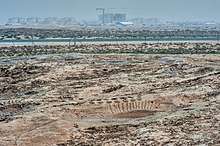
Abu Dhalouf and Ar Ru'ays were the largest villages on the northern coastline until the 1970s, when the Qatari government enacted a plan to establish Madinat ash Shamal between these two villages. Throughout the 1970s, a road system and a port were built to connect the three villages. Development of Madinat ash Shamal continued through the 1980s and 1990s, whereas urban developments were carried out on the adjacent settlements of Abu Dhalouf and Ar Ru'ays in the 2000s. At present, these three villages are the commercial and administrative centers of the municipality.[10]
The majority of Al Shamal's settlements are rural, consisting mainly of small villages and farms. Most of Qatar's archaeological sites, abandoned villages and protected areas can be found in the municipality.[10] Development is mainly oriented towards the three adjacent villages of Madinat ash Shamal, Abu Dhalouf and Ar Ru'ays, and the village of Ain Sinan, with the bulk of development occurring in Madinat ash Shamal.[13]
Climate
The following is climate data for the town of Ar Ru'ays on the northern coast.
| Climate data for Ar Ru'ays | |||||||||||||
|---|---|---|---|---|---|---|---|---|---|---|---|---|---|
| Month | Jan | Feb | Mar | Apr | May | Jun | Jul | Aug | Sep | Oct | Nov | Dec | Year |
| Average high °C (°F) | 22 (72) |
24 (75) |
28 (82) |
34 (93) |
39 (102) |
42 (108) |
43 (109) |
43 (109) |
40 (104) |
35 (95) |
30 (86) |
25 (77) |
34 (93) |
| Average low °C (°F) | 13 (55) |
14 (57) |
17 (63) |
22 (72) |
27 (81) |
30 (86) |
31 (88) |
32 (90) |
29 (84) |
26 (79) |
18 (64) |
14 (57) |
23 (73) |
| Average precipitation mm (inches) | 13 (0.5) |
2 (0.1) |
2 (0.1) |
5.5 (0.22) |
1 (0.0) |
0 (0) |
0 (0) |
0 (0) |
0 (0) |
0.5 (0.02) |
15 (0.6) |
23 (0.9) |
62 (2.44) |
| Average relative humidity (%) | 77 | 71 | 57 | 52 | 41 | 40 | 43 | 53 | 58 | 61 | 70 | 83 | 59 |
| Source: Qatar Statistics Authority[14] | |||||||||||||
Administration
The municipality is divided into 3 zones which are then divided into 162 blocks.[15] According to municipal officials, there are approximately 28 rural settlements of varying sizes situated outside the Madinat ash Shamal area. The majority of these settlements are nestled along Al Shamal Road. There is also a high propensity of abandoned villages scattered throughout the municipality.[16]
Administrative zones
The following zones were recorded in the 2015 population census:[1]
| Zone no. | Settlements | Area (km²) | Population (2015) |
|---|---|---|---|
| 77 | Ain Sinan Madinat Al Kaaban Fuwayrit | 266.0 | 1,727 |
| 78 | Abu Dhalouf Zubarah | 427.2 | 1,660 |
| 79 | Madinat ash Shamal Ar Ru'ays | 166.6 | 5,407 |
| Municipality | 859.8 | 8,794 | |
Other settlements
Other settlements, abandoned villages and sites of interest in Al Shamal include:
- Ain Al Nuaman – village near the municipality's south-west coast.[17]
- Ain Mohammed – abandoned village near the municipality's north-west coast.[18] Hosts the Ain Mohammed Fort.[17]
- Al `Adhbah – village near the municipality's north-east coast.[17]
- Al `Arish – abandoned fishing village near the municipality's north-west coast.[19]
- Al Ghariyah – village near the municipality's north-east coast.[17]
- Al Ghashamiya – village near the municipality's east coast.[17]
- Al Huwaila – abandoned village near the municipality's south-east coast.[17] Previously served as Qatar's main town before the emergence of Zubarah and Fuwayrit.[20]
- Al Jumail – abandoned fishing village near the municipality's north-west coast.[19]
- Al Khasooma – coastal area near the municipality's north coast, east of Ar Ru'ays.[17]
- Al Khuwayr – abandoned fishing village near the municipality's north-west coast.[19]
- Al Mafjar – abandoned village near the municipality's north-east coast.[17][21]
- Al Marroona – village near the municipality's south-east coast.[17]
- Al Nabaah – abandoned village near the municipality's north-west coast.[17]
- Al Qa`abiyah – village near the north-center of Al Shamal.[17]
- Al Zeghab – village on the outskirts of Madinat ash Shamal.[17]
- Ar Rakiyat – village near the municipality's north-west coast.[17]
- Ath Thaqab – village near the municipality's north-west coast.[17]
- Freiha – abandoned village near the municipality's south-west coast.[17] It is closely associated with the historic town of Zubarah.[22]
- Ghaf Makin – village near the municipality's north-west coast.[17]
- Jebel Jassassiyeh – abandoned village near the municipality's north-east coast.[17]
- Khidaj – abandoned village near the municipality's north-west coast.[17]
- Lejthaya – village near the municipality's south-east coast.[17]
- Lisha – village near the municipality's east coast.[17]
- Murwab – abandoned village near the municipality's south-west coast.[17] It constitutes one of Qatar's largest Islamic-era settlements.[22]
- Ras Al Shindwie – village near the municipality's northern tip.[17]
- Ruwayda – abandoned village near the municipality's north-west coast.[17] It constitutes one of Qatar's largest archaeological sites.[22]
- Safya – village near the municipality's east coast, to the immediate south of the original village of Fuwayrit.[17]
- Sidriyat Makin – village near the municipality's north-west coast.[17]
- Umm Al Ghaylam – village near the north-center of Al Shamal.[17]
- Umm Al Hawa'ir – village near the municipality's north-east coast.[17]
- Umm Al Kilab – village near the center of Al Shamal.[17]
- Umm al Qubur – abandoned village near the municipality's south-west coast.[17]
- Umm Al Shuwail – abandoned site containing a fort located 1.1 km east of Zubarah.[23]
- Umm Jasim – village near the municipality's north-west coast.[17]
- Yoghbi – abandoned village near the municipality's south-west coast. It accommodates the earliest known Islamic-era settlement in Qatar.[24]
- Yusufiyah – abandoned village near the municipality's north-west coast.[17]
- Zarqa – village near the municipality's north-east coast.[17]
Organizational structure

Ash-Shamal Municipality comprises four principal departments headed and managed by Hamad Jumaa Al Mannai, mayor of ash-Shamal Municipality as of 2016.[25]
The director's office, heading the director's assistants and the heads of the following departments:[26]
- Municipal Control Department
- Services Department
- Public Affairs Department
- Technical Affairs Department
Infrastructure

Education
Government statistics indicate that in 2015 the municipality accommodated 8 schools.[27] The majority of these schools are located in the northern portion of the municipality.[28]
Healthcare
There is one primary healthcare center in the municipality, located in Madinat ash Shamal. Residents in Al Shamal's eastern section, including Ain Sinan, are served by healthcare centers in Al Khor.[28]
Development projects
Commercial fishing activities and cargo transport take place primarily at Ar Ru'ays Port, one of the three primary ports of Qatar.[29] Starting in 2010, the Public Works Authority (Ashghal) in Qatar carried out development on the port.[30] The development included construction of a basin, deepening the channel at 2900 meter length, passenger jetty, commercial crew jetty, protection wall, storage areas, government offices, workshops, and passenger terminal building.[31] Ar Ru'ays Port Development Project, which has the stated aim of "transforming Ar Ru'ays Port into northern Qatar's pathway to the world", was launched in January 2015.[32]
North of Fuwayrit, a major desalination plant is under development, while an expansion of a sewage treatment situated south of Madinat ash Shamal will supply local farmers with treated sewage effluent for agricultural use.[10]
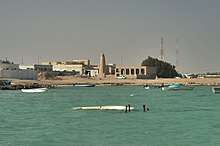
The Public Works Authority (Ashghal) unveiled in October 2017 that they had begun the process of implementing more than 20 construction projects in the municipality at a cost exceeding QR 2.2 billion with a planned completion date of 2022. Roughly 60% of the total budget was to be spent on improving already-existing infrastructure while the remainder would be spent on funding new projects.[33]
As part of the plan, the municipality's transport system would see major improvements with its 73-km road system being renovated and the construction of 12 new intersections, 28 km of sidewalks, 8,000 parking spaces and 3,680 light poles. Most of these renovations and additions are set to take place near the municipality's major cities on its northern tip and its eastern section, near Al Huwailah. Also in the works was a 91 km sewage network. Most major sanitation facilities are to be located near Madinat ash Shamal and Ar Ru'ays. In Madinat ash Shamal, a 25,000 square meter healthcare facility and six educational institutes are to be constructed as part of this project.[33] Furthermore, several of the construction projects are intended to supplement the Ar Ru'ays Port.[34]
Transport
Al Shamal Road is the major highway facilitating travel to the capital Doha,[10] as well as between many villages within the municipality. Another important road is Al Zubarah Road, which links Zubarah to the Al Khor Municipality.[35] The Qatar–Bahrain Causeway was a major development project which would provide a causeway between Qatar and Bahrain near the town of Zubarah,[36] however, after several postponements, it is unclear if the project is still underway.[37]
Economy
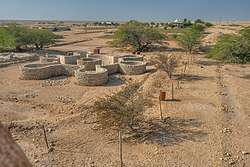
Industry
Al Shamal Industrial Area is the region's industrial hub. The municipality's long-term development plan suggests that the area will cater to light and medium industries such as manufacturing, construction and logistics, benefiting both Ar Ru'ays Port and the urban development of its principal towns.[38]
Agriculture
Around 14 sizable farming regions exist in the municipality, in the settlements of Ain Al Nuaman, Murwab, Zubarah, Lisha, Al `Arish, Ath Thaqab, Ar Ru'ays, Abu Dhalouf and Al Jumail in the west, and Al Mafjar, Athba Al Shamaliyya, Ain Sinan, Madinat Al Kaaban, and Al Jethay in the east.[39]
In 2010, the municipality recorded 115 farms spanning its area while the Ministry of Municipality & Urban Planning documented 125 farms, constituting about 12% of all of Qatar's farms at that time. Most of the farms were based in the eastern section, with Madinat Al Kaaban having the highest concentration.[39]
Qatar's inaugural privately owned large-scale fishing project was launched in the Al Shamal Industrial Area in October 2017. Up to 2,000 tonnes of fish will be supplied every year for domestic consumption by the fish farm.[40]
Sports
Al-Shamal SC, a sports club most notable for its football team which competes in the Qatargas League, is situated in the city. Their home games are played at Al-Shamal SC Stadium in Madinat ash Shamal. Another stadium of the same name, Al-Shamal Stadium, is a proposed 45,120 capacity multi-purpose stadium currently under construction for the 2022 FIFA World Cup.[5]
Visitor attractions
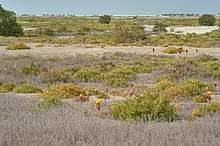
The Qatar Tourism Authority (QTA) is in the process of developing Al Shamal's historic villages, archaeological sites and natural areas into tourist attractions. As the municipality currently has the highest annual precipitation rate in the country and a large coastline area, the QTA has prioritized the establishment of eco-reserves in certain areas. Islands such as Ras Rakan and Umm Tais have been developed as nature reserves in order to boost eco-tourism.[5]
The Al Reem Biosphere Reserve is a protected area in western Al Shamal measuring 1,189 square kilometers in area. This area encompasses the archaeological site of Zubarah and the Al Ishriq Wildlife Breeding Center. Several reintroduced species are found in this area such as sand gazelles and ostriches, in addition to native species such as dugongs, spiny-tailed lizards and red foxes.[11]
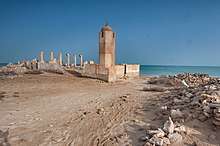
Ar Ru'ays' coastal area is a popular destination due to its lush vegetation. In recent years, the Ministry of Municipality and Environment have embarked on campaigns to restore the mangroves that grow abundantly on its coast.[41] Also located along the coast of Ar Ru'ays is the Al Shamal Corniche, a seafront promenade with a length of 2,570 meters.[42] It was announced in 2017 that Qatar's largest health resort, due to cover 250,00 sq meters, will be built in Khasooma, east of Ar Ru'ays.[43]
Abandoned villages are also being restored and converted into tourist attractions. Jumail, a fishing village abandoned in the 1970s and located 5 km away from Ar Ru'ays, is one example. After being partially reconstructed in 2009, the government announced its plans in late 2015 to convert the village into a museum. Containing no less than 60 crumbled structure, Jumail is thought to date back to the 19th century and had a close connection to Ruwayda, another ruined village situated 1 km away which accommodates the remains of what is possibly the largest fort in Qatar.[44]
According to statistics made available by the Ministry of Municipality and Environment, the municipality was said to accommodate 5 parks in 2018.[45]
Forts
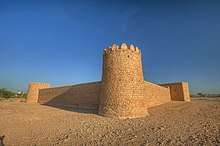
As a result of the gradual urbanization of the various nomadic Qatari tribes in Al Shamal's past, numerous historic forts are found throughout the municipality. Many of these forts were built to protect scarce water resources, while others were to protect from invasions by neighboring tribes.[46] Most prominent is the historic Zubarah Fort, built in 1938 and converted to a museum in 1987. This fort was built as a coast guard station and is now the center of the Zubarah archaeological site.[47] A short distance away from Zubarah Fort is Qal'at Murair, which was built to defend Zubarah's inland wells.[48]
Approximately 8 km northeast of Zubarah Fort is the multi-purpose Ar Rakiyat Fort.[49] Constructed around the 19th century to protect the water supply of Ar Rakiyat and to fend off invasions, this fort was restored by Qatar Museums in 1988.[50] An older fort is found 2 km away from Ar Rakiyat, near the abandoned village of Ath Thaqab.[49] Like most other Qatari forts, Ath Thaqab Fort is rectangular in shape and has four main towers. It dates to somewhere between the 17th and 19th centuries.[51]
Umm Al Maa Fort, also near Zubarah, dates to the 19th century and only its base structure has been preserved.[52] Similarly, Yusufiya Fort is dated to the 19th century and has only retained its base structure. Artifacts dating to the 13th century have been discovered at this fort.[51]
Archaeological sites
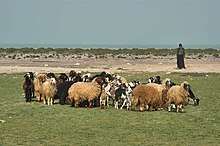
A cluster of Abbasid-period (750–1253) archaeological sites are found near the north-west coast and include Ar Rakiyat, Umm Al Kilab, Ghaf Makin, Mussaykah, Murwab, and Al-Haddiyah. Structures that were excavated at these sites were roughly aligned with Mecca. All of the sites are situated next to rawdas (depressions), ensuring a reliable water supply.[53]
Demographics
| Year | Pop. | ±% |
|---|---|---|
| 1986[54][55] | 4,380 | — |
| 1997[54][55] | 4,059 | −7.3% |
| 2004[54][55] | 4,915 | +21.1% |
| 2010[56] | 7,975 | +62.3% |
| 2015[1] | 8,794 | +10.3% |
| c-census; e-estimate | ||
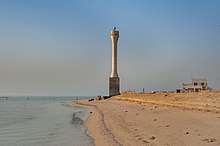

The following table is a breakdown of registered live births by nationality and sex for Al Shamal. Places of birth are based on the home municipality of the mother at birth.[57]
| ||||||||||||||||||||||||||||||||||||||||||||||||||||||||||||||||||||||||||||||||||||||||||||||||||||||||||||||||||||||||||||||||||||||||||||||||||||||||||||||||||||||||||||||||||||||||||||||||||||||||||||||||||||||||||||||||||||||||||||||||||||||||||||||||||||||||||||||||||||||||||||||||||
References
- "2015 Population census" (PDF). Ministry of Development Planning and Statistics. April 2015. Retrieved 8 August 2017.
- "Archived copy". Archived from the original on 2011-09-03. Retrieved 2011-09-09.CS1 maint: archived copy as title (link)
- "About Qatar". Civil Aviation Authority. Archived from the original on 9 August 2017. Retrieved 9 August 2017.
- "Al Shamal Municipality". Ministry of Municipality and Urban Planning. Retrieved 28 June 2015.
- "Al Shamal Regaining past glory". The Peninsula Qatar. 6 January 2013. Archived from the original on 24 July 2015. Retrieved 24 July 2015.
- Fromherz, Allen (13 April 2012). Qatar: A Modern History. Georgetown University Press. p. 4.
- The Persian Gulf pilot: comprising the Persian Gulf, Gulf of Omán; and Makran coast. Great Britain: Hydrographic Dept. 1890. p. 126. This article incorporates text from this source, which is in the public domain.
- Walmsley, Alan; Richter, Tobias; Nymann, Hanne; Wordsworth, Paul David (2012). "Qatar Islamic Archaeology and Heritage Project : End of Season Report : 2010-2011" (PDF). University of Copenhagen and Qatar Museums Authority. pp. 94–97. Retrieved 18 February 2019.CS1 maint: uses authors parameter (link)
- Robert Carter and Daniel Eddisford (June 2016). "Origins of Doha Project - Season 4 Archive Report: Fuwairit Standing Building Recording" (PDF). Origins of Doha Project. p. 7. Retrieved 21 July 2018.
- "Al Shamal Municipality: Vision and Development Strategy" (PDF). Ministry of Municipality and Environment. December 2017. p. 4. Retrieved 22 May 2018.
- "Al Shamal Municipality: Vision and Development Strategy" (PDF). Ministry of Municipality and Environment. December 2017. p. 26. Retrieved 22 May 2018.
- "Geonames Sortable Table". arcgis.com. Geographic Information Systems Department (Qatar). Retrieved 13 February 2019.
- "Al Shamal Municipality: Vision and Development Strategy" (PDF). Ministry of Municipality and Environment. December 2017. p. 15. Retrieved 22 May 2018.
- "Temperature/Humidity/Rainfall". Qatar Statistics Authority. Archived from the original on 2013-03-22. Retrieved 24 June 2018.
- "Administrative boundary map". Ministry of Development Planning and Statistics. Retrieved 10 July 2018.
- "Al Shamal Municipality: Vision and Development Strategy" (PDF). Ministry of Municipality and Environment. December 2017. p. 19. Retrieved 22 May 2018.
- "District map". The Centre for Geographic Information Systems of Qatar. Retrieved 25 May 2018.
- Richter, T., & Nymann, H. (2011). "Qatar Islamic Archaeology and Heritage Project: End of Season Report: Stage 2, Season 1, 2009–2010" (PDF). University of Copenhagen and Qatar Museums Authority. p. 302. Retrieved 23 June 2018.CS1 maint: uses authors parameter (link)
- "Fishermens' villages". Explore Qatar. Retrieved 23 June 2018.
- "Marhaba's Guide to Archaeological Sites, Forts & Ruins in Qatar". Marhaba. 16 August 2015. Retrieved 23 June 2018.
- Shereen D’Souza and Buthyna Al-Mohammadi (17 August 2017). "17 best roads to travel in Qatar". Time Out Doha. Retrieved 23 June 2018.CS1 maint: uses authors parameter (link)
- "Settlements of Qatar". Qatar Museums. Retrieved 23 June 2018.
- Walmsley, Alan; Richter, Tobias; Nymann, Hanne; Wordsworth, Paul David (2012). "Qatar Islamic Archaeology and Heritage Project : End of Season Report : 2010-2011" (PDF). University of Copenhagen and Qatar Museums Authority. p. 117. Retrieved 18 February 2019.CS1 maint: uses authors parameter (link)
- "QM, UCL Qatar discover the earliest Islamic site in Qatar". Gulf Times. 6 March 2019. Retrieved 10 March 2019.
- "3 مديرين جدد للدوحة والشحانية والظعاين" (in Arabic). Al Raya. 18 July 2016. Retrieved 8 August 2017.
- "تعيين 112 مديراً ورئيساً لقسم ومكتب في 8 بلديات" (in Arabic). Al Sharq. 21 April 2017. Retrieved 8 August 2017.
- "The Simplified Census of Population, Housing & Establishments 2015" (PDF). Ministry of Municipality and Environment. April 2015. pp. 65–66. Retrieved 8 August 2017.
- "Al Shamal Municipality: Vision and Development Strategy" (PDF). Ministry of Municipality and Environment. December 2017. p. 20. Retrieved 22 May 2018.
- "About Us". Qatar Ports Management Co. Archived from the original on 30 June 2018. Retrieved 29 June 2018.
- "Development of Al-Ruwais Port - Phase 2". Construction Week Online. 13 May 2010. Archived from the original on 8 August 2017. Retrieved 8 August 2017.
- "Notable Contracts" (PDF). Readymix Qatar L.L.C. 23 November 2011. Archived from the original (PDF) on 14 May 2013. Retrieved 8 August 2017.
- "Premier launches Al Ruwais Port development project". Qatar Is Booming. 10 January 2015. Retrieved 23 May 2018.
- "Over 20 projects by Ashghal for Al Shamal and Ruwais under way". The Peninsula. 22 October 2017. Retrieved 25 June 2018.
- "QR2.2bn projects implemented in Shamal, Ruwais". Gulf Times. 22 October 2017. Retrieved 25 June 2018.
- "Al Shamal Municipality: Vision and Development Strategy" (PDF). Ministry of Municipality and Environment. December 2017. pp. 29–30. Retrieved 22 May 2018.
- "Al Shamal Municipality: Vision and Development Strategy" (PDF). Ministry of Municipality and Environment. December 2017. p. 15. Retrieved 22 May 2018.
- Peter Kovessy (1 May 2016). "Saudi politician calls for new causeway to Qatar". Doha News. Retrieved 23 May 2018.
- "Al Shamal Municipality: Vision and Development Strategy" (PDF). Ministry of Municipality and Environment. December 2017. p. 16. Retrieved 20 July 2018.
- "Qatar Atlas: Agriculture/Industry: Agriculture". Qatar Statistics Authority. Archived from the original on 2013-03-22. Retrieved 24 June 2018.
- "Land allotted to first private fish farming project". The Peninsula. 15 October 2017. Retrieved 20 July 2018.
- "MME restores mangroves in Al Ruwais coastal area". The Peninsula. 18 May 2018. Retrieved 25 June 2018.
- "Opening of Al Shamal Corniche Development Project". Ashghal. 13 May 2018. Retrieved 10 July 2018.
- "منتجع سيـاحي صحـي بالشمال" (in Arabic). Al Watan. 15 March 2017. Retrieved 9 August 2017.
- Peter Kovessy (16 October 2015). "Qatar to turn crumbling fishing village into open-air museum". Doha News. Retrieved 29 May 2018.
- "تطور غير مسبوق في تصميم وإنشاء الحدائق العامة بالدولة" (in Arabic). Ministry of Municipality and Environment. 26 June 2018. Retrieved 8 July 2018.
- "North forts". Explore Qatar. Retrieved 23 May 2018.
- T. Kersten, K. Mechelke and L. Maziull (February 2015). "3D Model of Al Zubarah Fortress in Qatar" (PDF). The International Archives of the Photogrammetry, Remote Sensing and Spatial Information Sciences. Retrieved 23 May 2018.CS1 maint: uses authors parameter (link)
- "Al Zubarah". Qatar Museums. Retrieved 23 May 2018.
- Kozah, Mario; Abu-Husayn, Abdulrahim; Al-Murikhi, Saif Shaheen; Al-Thani, Haya (2014). The Syriac Writers of Qatar in the Seventh Century (print ed.). Gorgias Press LLC. p. 31. ISBN 978-1463203559.
- Kozah, Mario; Abu-Husayn, Abdulrahim; Al-Murikhi, Saif Shaheen; Al-Thani, Haya (2014). The Syriac Writers of Qatar in the Seventh Century (print ed.). Gorgias Press LLC. p. 33. ISBN 978-1463203559.
- "قلاع قطر… حصون للحماية" (in Arabic). Al-Hakawati. 28 December 2011. Retrieved 23 May 2018.
- "Umm Al Maa". Qatar Entertainer. Retrieved 23 May 2018.
- Phillip G. Macumber (2015). "Water Heritage in Qatar" (PDF). Cultural Heritages of Water: Thematic Study on The Cultural Heritages of Water in the Middle East and Maghreb. UNESCO World Heritage Convention. UNESCO. p. 226. Retrieved 5 July 2018.
- "Population from 1986–2009". Qatar Statistics Authority. Archived from the original on 24 September 2015. Retrieved 28 June 2015.
- "Population and social statistics". Qatar Statistics Authority. 2004. Archived from the original on 24 September 2015. Retrieved 28 June 2015.
- "2010 population census" (PDF). Qatar Statistics Authority. Archived from the original (PDF) on 2 April 2015. Retrieved 13 March 2015.
- "Home page". Ministry of Development Planning and Statistics. Retrieved 11 August 2017.
- "Vital Statistics Annual Bulletin (Births & Deaths): 1984" (PDF). Central Statistical Organization (Qatar). September 1985. Retrieved 8 July 2018.
- "Vital Statistics Annual Bulletin (Births & Deaths): 1985" (PDF). Central Statistical Organization (Qatar). June 1986. Retrieved 8 July 2018.
- "Vital Statistics Annual Bulletin (Births & Deaths): 1986" (PDF). Central Statistical Organization (Qatar). June 1987. Retrieved 8 July 2018.
- "Vital Statistics Annual Bulletin (Births & Deaths): 1987" (PDF). Central Statistical Organization (Qatar). June 1988. Retrieved 8 July 2018.
- "Vital Statistics Annual Bulletin (Births & Deaths): 1988" (PDF). Central Statistical Organization (Qatar). June 1989. Retrieved 8 July 2018.
- "Vital Statistics Annual Bulletin (Births & Deaths): 1989" (PDF). Central Statistical Organization (Qatar). May 1990. Retrieved 8 July 2018.
- "Vital Statistics Annual Bulletin (Births & Deaths): 1990" (PDF). Central Statistical Organization (Qatar). May 1991. Retrieved 8 July 2018.
- "Vital Statistics Annual Bulletin (Births & Deaths): 1991" (PDF). Central Statistical Organization (Qatar). June 1992. Retrieved 8 July 2018.
- "Vital Statistics Annual Bulletin (Births & Deaths): 1992" (PDF). Central Statistical Organization (Qatar). June 1993. Retrieved 8 July 2018.
- "Vital Statistics Annual Bulletin (Births & Deaths): 1993" (PDF). Central Statistical Organization (Qatar). April 1994. Retrieved 8 July 2018.
- "Vital Statistics Annual Bulletin (Births & Deaths): 1995" (PDF). Central Statistical Organization (Qatar). May 1996. Retrieved 8 July 2018.
- "Vital Statistics Annual Bulletin (Births & Deaths): 1996" (PDF). Central Statistical Organization (Qatar). June 1997. Retrieved 8 July 2018.
- "Vital Statistics Annual Bulletin (Births & Deaths): 1997" (PDF). Central Statistical Organization (Qatar). June 1998. Retrieved 8 July 2018.
- "Vital Statistics Annual Bulletin (Births & Deaths): 1998" (PDF). The Planning Council of the General Secretariat. June 1999. Retrieved 8 July 2018.
- "Vital Statistics Annual Bulletin (Births & Deaths): 1999" (PDF). The Planning Council of the General Secretariat. July 2000. Retrieved 8 July 2018.
- "Vital Statistics Annual Bulletin (Births & Deaths): 2000" (PDF). The Planning Council of the General Secretariat. April 2001. Retrieved 8 July 2018.
- "Vital Statistics Annual Bulletin (Births & Deaths): 2001" (PDF). The Planning Council of the General Secretariat. June 2002. Retrieved 8 July 2018.
- "Vital Statistics Annual Bulletin (Births & Deaths): 2002" (PDF). The Planning Council of the General Secretariat. June 2003. Retrieved 8 July 2018.
- "Vital Statistics Annual Bulletin (Births & Deaths): 2003" (PDF). The Planning Council of the General Secretariat. April 2004. Retrieved 8 July 2018.
- "Vital Statistics Annual Bulletin (Births & Deaths): 2004" (PDF). The Planning Council of the General Secretariat. June 2005. Retrieved 8 July 2018.
- "Vital Statistics Annual Bulletin (Births & Deaths): 2005" (PDF). The Planning Council of the General Secretariat. September 2006. Retrieved 8 July 2018.
- "Vital Statistics Annual Bulletin (Births & Deaths): 2006" (PDF). Qatar Statistics Authority. August 2007. Retrieved 8 July 2018.
- "Vital Statistics Annual Bulletin (Births & Deaths): 2007" (PDF). Qatar Statistics Authority. July 2008. Retrieved 8 July 2018.
- "Vital Statistics Annual Bulletin (Births & Deaths): 2008" (PDF). Qatar Statistics Authority. 2009. Retrieved 8 July 2018.
- "Vital Statistics Annual Bulletin (Births & Deaths): 2009" (PDF). Qatar Statistics Authority. July 2010. Retrieved 8 July 2018.
